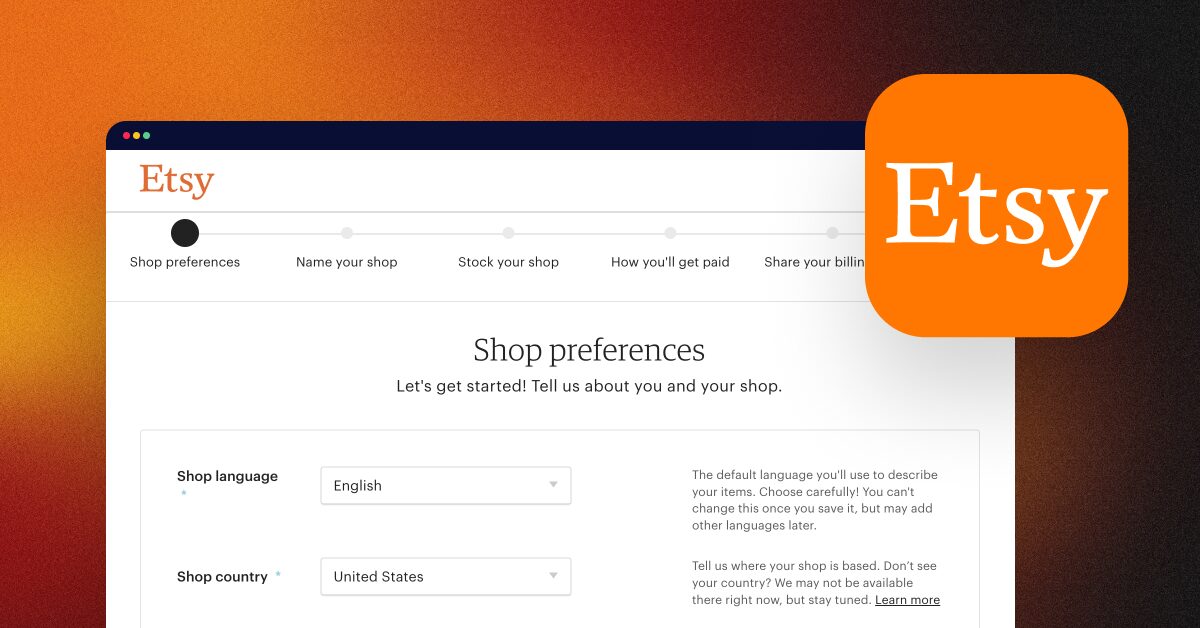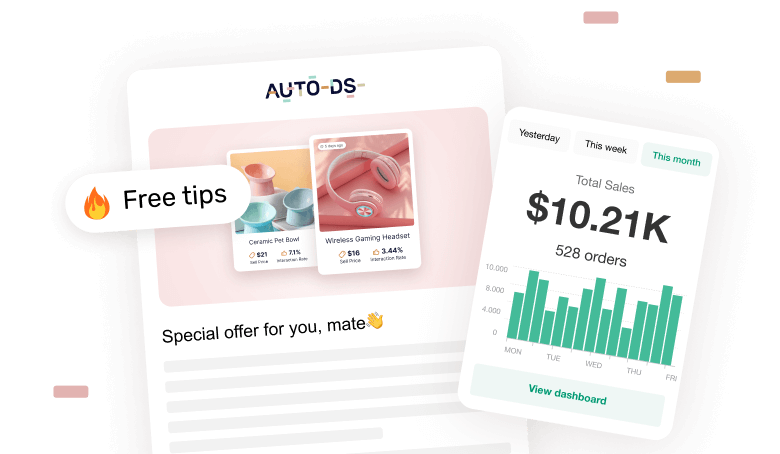Thinking about opening an Etsy store? Good idea. Etsy is one of the best platforms to launch a creative online business and target shoppers looking for authentic items. Why? Because these tend to be pricier and more profitable than generic ones, usually found on other selling channels. This also applies if you’re working with print-on-demand or dropshipping.
The key to success? Partnering with dropshipping platforms that make the entire dropshipping process smoother. AutoDS automates everything from product import to order fulfillment while also staying compliant with Etsy’s dropshipping policies—all from one single dashboard.
In this guide, we’ll walk you through how to set up your Etsy store for dropshipping step by step. We’ll include everything you need to know: from choosing your niche and setting up payments to connecting with third-party platforms like AutoDS and launching your first listings.
Etsy is a powerful platform for creative dropshippers. With its built-in audience and focus on personalized, unique products, Etsy is ideal for print-on-demand and niche-driven dropshipping stores.
Setting up your store is simple. Then, you can rely on automation to import items in bulk, optimize listings, and set up pricing rules.
Standing out comes down to branding, SEO, and automation. Well-written listings, eye-catching visuals, and automated fulfillment will help you rise above the rest on Etsy.
Why Sell on Etsy? (Especially for POD/Dropshippers)
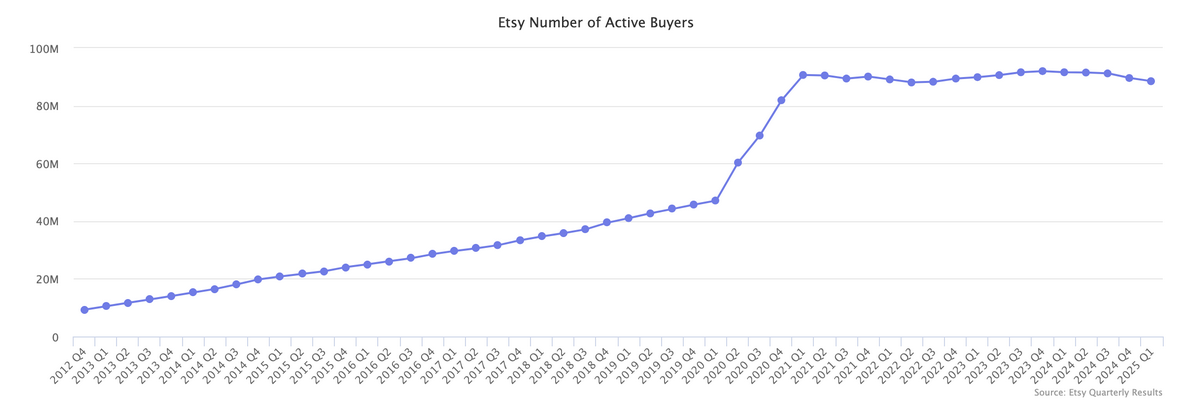
Long ago, Etsy used to feel like an online thrift shop or flea market for vintage finds. But not anymore. Now it’s a full-on marketplace for creative entrepreneurs. Just look at the numbers: by 2025, Etsy has over 90 million active buyers—a huge revenue opportunity.
And, unlike generic marketplaces, it doesn’t bring just any traffic. It appeals mostly to shoppers looking for unique, high-quality products. For dropshippers, that’s a huge win. You can offer custom mugs, T-shirts, wall art, jewelry, you name it. As long as they feel unique and authentic, they’re welcome on Etsy. First, that’s great for branding. But, mostly, it’s great for revenue.
Higher perceived value? Check. Room for better margins? Double check. Less competition? Triple check. Etsy favors originality, so your product doesn’t have to fight a hundred near-identical listings like it would on Amazon or eBay.
The cherry on top? Automation. When connected with tools like AutoDS, you can import products, automate fulfillment, and track everything from one single place. All in all, this makes Etsy dropshipping scalable, profitable, and low-risk.
How to Set Up an Etsy Shop for Dropshipping
Ready to turn your Etsy idea into a real store? Setting up an account is pretty straightforward, as it mainly involves following a few prompts. But there are some things to keep in mind for each step. So, next, we’ll break it down step by step so you can just follow our instructions.
Step 1: Choose Your Niche and Store Name
Before you get started, define the big picture. What are you selling? Who are you targeting? And what makes you unique in a digital shopping mall full of shops? Etsy favors stores with a clear theme and an authentic offering. Are you selling custom pet portraits? Vintage-style t-shirts? Boho jewelry? Pick a niche that fits your vibe and your audience’s interest based on what you’re selling.
With that information, start thinking about your brand’s personality. That will give you enough information to choose a name. Think short, catchy, and relevant. Make it memorable. Avoid anything too generic or hard to spell. You want shoppers to remember you and be able to find you easily on Google.
Once you have researched best-selling products on Etsy and your brand is crafted, let’s move on to creating your seller account.
Step 2: Create Your Etsy Seller Account
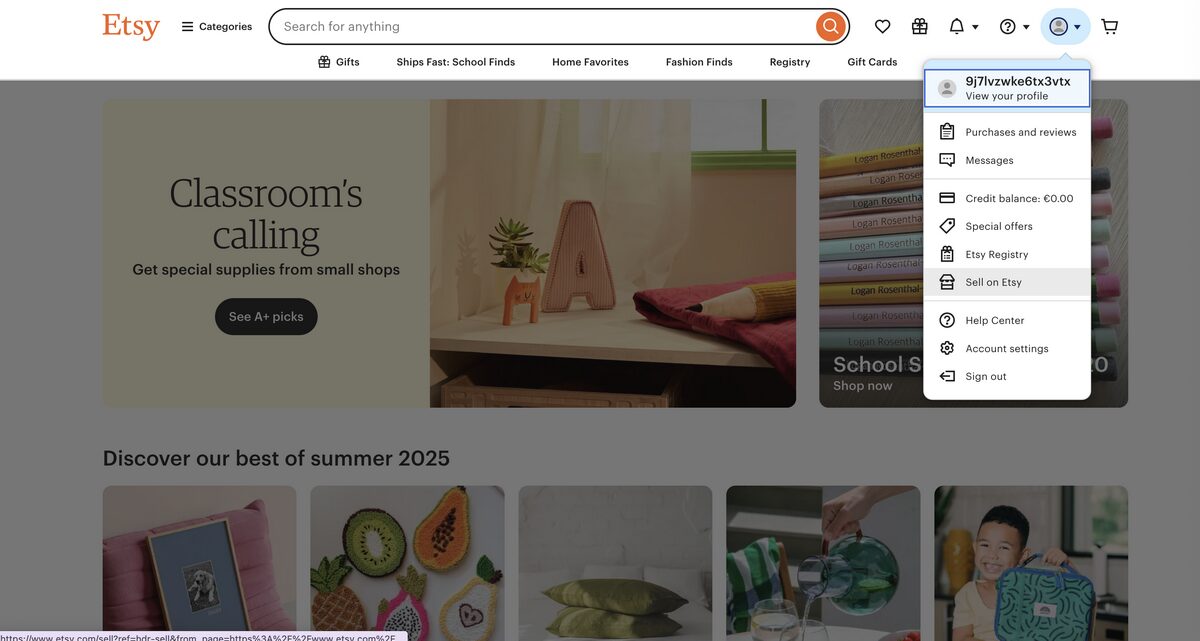
First things first: create your account. Head over to Etsy.com and click on “Sell on Etsy”. From there, you’ll be guided through multiple easy steps where you will complete with your information.
First, you will be asked to enter your email, name, and set a password. If you already have a personal Etsy account, you can just log in and convert it into a seller one.
🆕 Beginner’s Tip: Use a dedicated business email for your shop. It helps keep things clean, especially once orders start rolling in. Consider something like [email protected] or [email protected].
Step 3: Set Up Shop Preferences
Once you start the setup process, you will encounter two questions: what brought you to Etsy and what categories you’re interested in (vintage, handmade, or digital). This literally takes two seconds.
Then, the important part. You will reach a four-step setup where you have to fill out different forms with your business information. First, provide shop language, shop country, and shop currency. This step is crucial, as it sets the stage for what comes next.
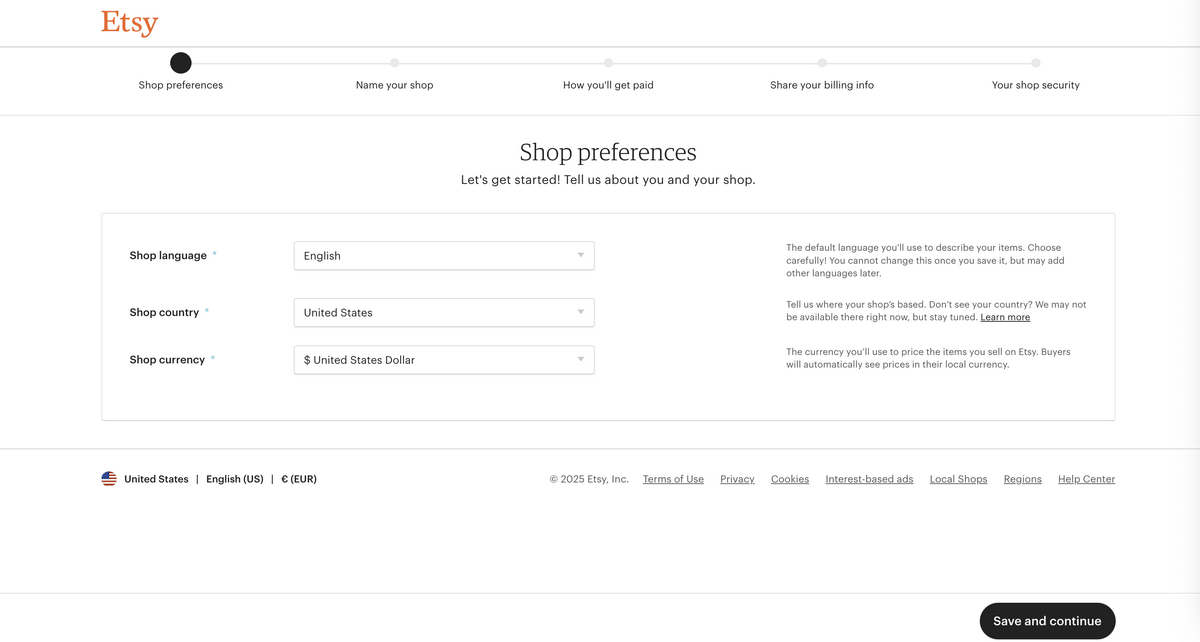
Next, write down the name you chose for your shop. For Etsy purposes, it has to be between 4 and 20 characters and include no accented letters or spaces. And no worries: you can change the name later if you are still unsure (you can do this from Info & Appearance under the Shop Name tab).

The third form asks for bank information, the type of seller you are (for tax purposes), and personal details, like country of residence, social security number, and taxpayer address. Then, provide billing information and, lastly, set up security measures for your account, like two-factor authentication.
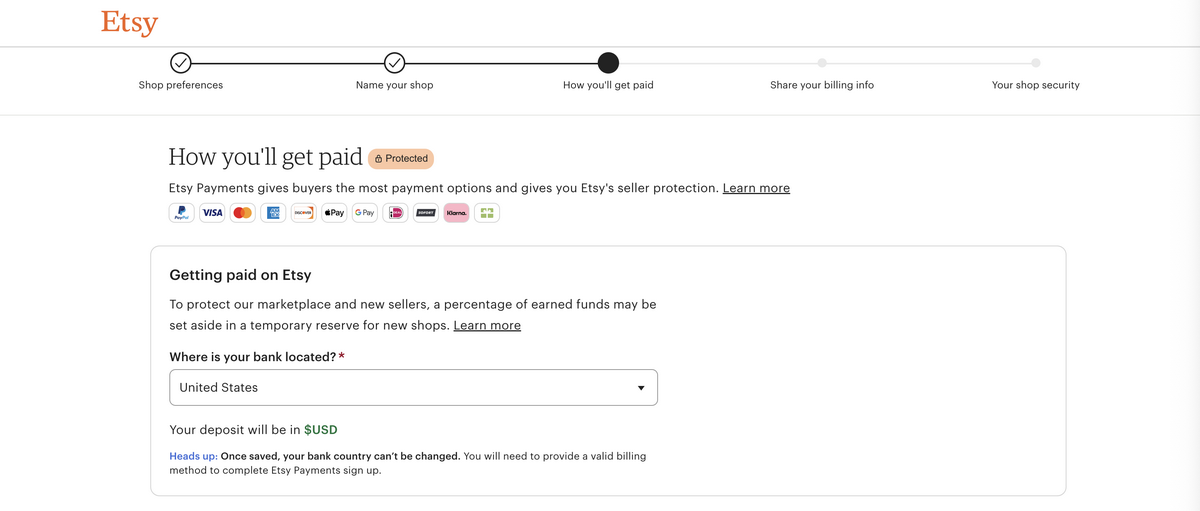
That’s it! Congratulations: you now have an official Etsy seller account.
🆕Beginner’s Tip: It’s important to note that Etsy charges a one-time fee of around $19 for opening a store, which you will have to pay right at the end of this setup process.
Pro Step: Connect Your Store To AutoDS
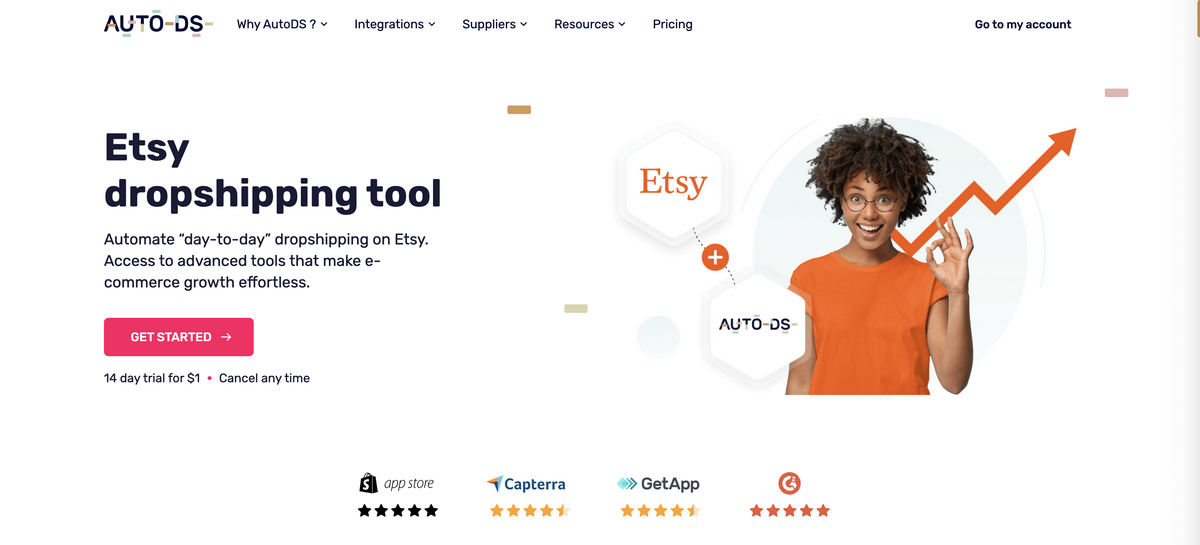
What if we told you that you can avoid the manual hassle of dropshipping before you even get started? Yes—before you import a product, you can set up AutoDS to handle it all behind the scenes.
With this integration, you can:
- Bulk import products in one click
- Automatically fulfill orders and sync them with your suppliers
- Send tracking info to your customers
- Use AI to generate high-converting titles and descriptions
- Monitor price and stock from suppliers and reflect changes automatically on your store
- Set pricing rules so they update automatically based on different patterns
Translation: less guesswork, fewer tabs open, no wasted time copying and pasting for hours. So, ready to connect AutoDS with Etsy? Let’s go step-by-step (it takes literally a few clicks, no big deal). The only thing you need to get started is an AutoDS account.
Once you are logged in, go to the main menu on the sidebar. If you don’t have any stores yet, click “Add Store”. If you already have other stores running, click on the name of your shop. Both will be located at the top left of the sidebar.
You will be directed to your store menu, where you will see all your current shops. There, click on “Add Store”. Then, for store type, select Etsy.
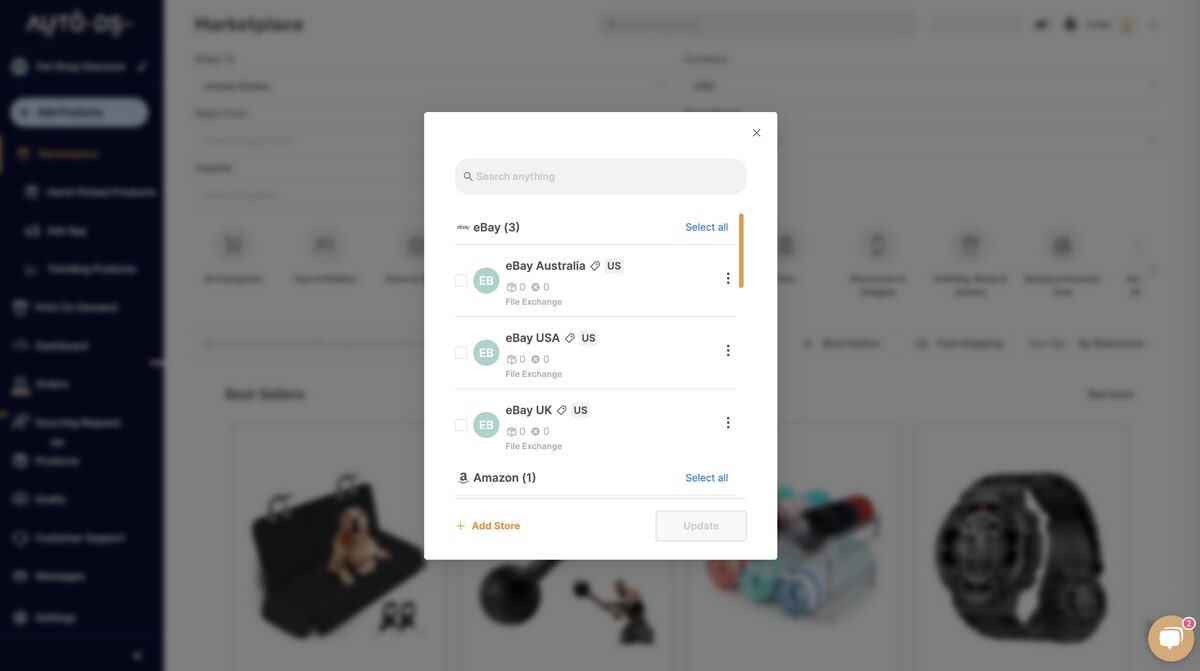
Finally, you will be redirected to Etsy to authorize AutoDS to connect to your store. Make sure to allow everything required.
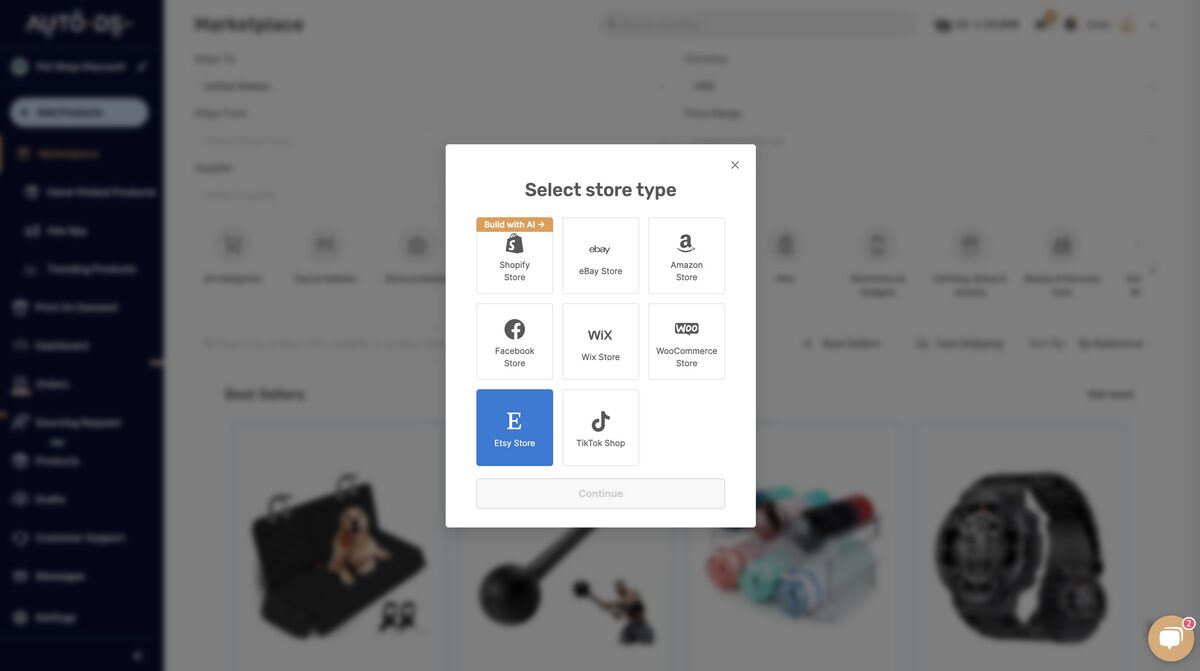
That’s it! It literally takes five clicks, and voilà. You now have an Etsy seller account connected to your dropshipping command center: AutoDS.
Ready to get started the smart way? Connect AutoDS to your Etsy store and get 14 days of full automation 👉 Start your $1 trial now!
Step 4: Add Your First Listings
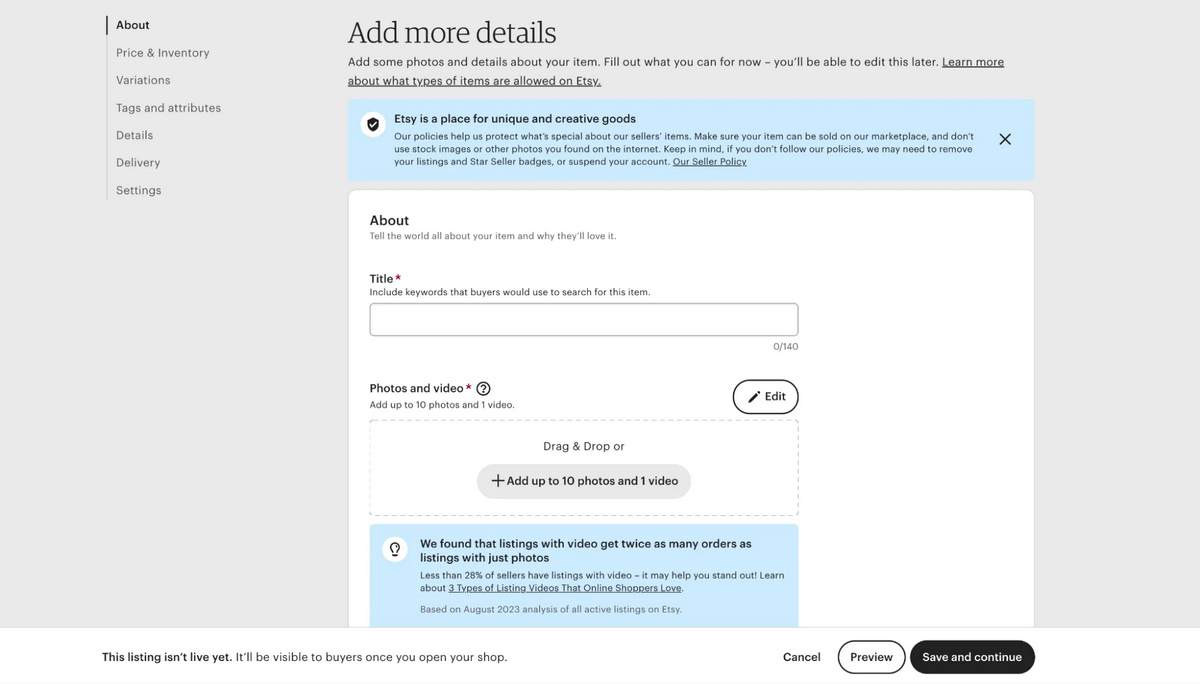
Now, it’s time to start filling your shop with products. Keep in mind that Etsy has a fee of $0.20 per listing, which is valid for four months. After the four months, the listing can auto renew (or renew manually) for $0.20 again. Each listing needs:
- Title
- Information about who made it (the seller, another member of the company, or a third party), what it is (a finished product or a tool to make things), and when it was made (not yet made, recently, or vintage).
- Category
- Color, size, and occasion (optional, but these help with SEO)
- Type of product (digital or physical)
- Description
- Product images
- Section and tags (optional)
- Materials (optional)
When creating your product listings, remember that how you craft them has a direct impact on your sales. Create titles that grab shoppers’ attention, write SEO-friendly descriptions with relevant keywords, upload good-quality images that actually reflect the real product, and complete as many fields as you can. This will help Etsy’s algorithms position your listings and increase your traffic.
💡Pro Tip: If you’re using AutoDS, you can bulk import in just a few clicks and even use AI tools to write optimized copy that sells.
Step 5: Set Up Payment & Shipping
Next up, your favorite part: how you’ll get paid. In step 3, when you were setting up your shop, you’ve already set up your billing info, including your bank and tax details. Once that’s connected, you’re good to receive payments.
The next step is to set up the price, inventory, and shipping for each listing. First, you’ll see Inventory and pricing, where you’ll establish a price and the quantity of available items.
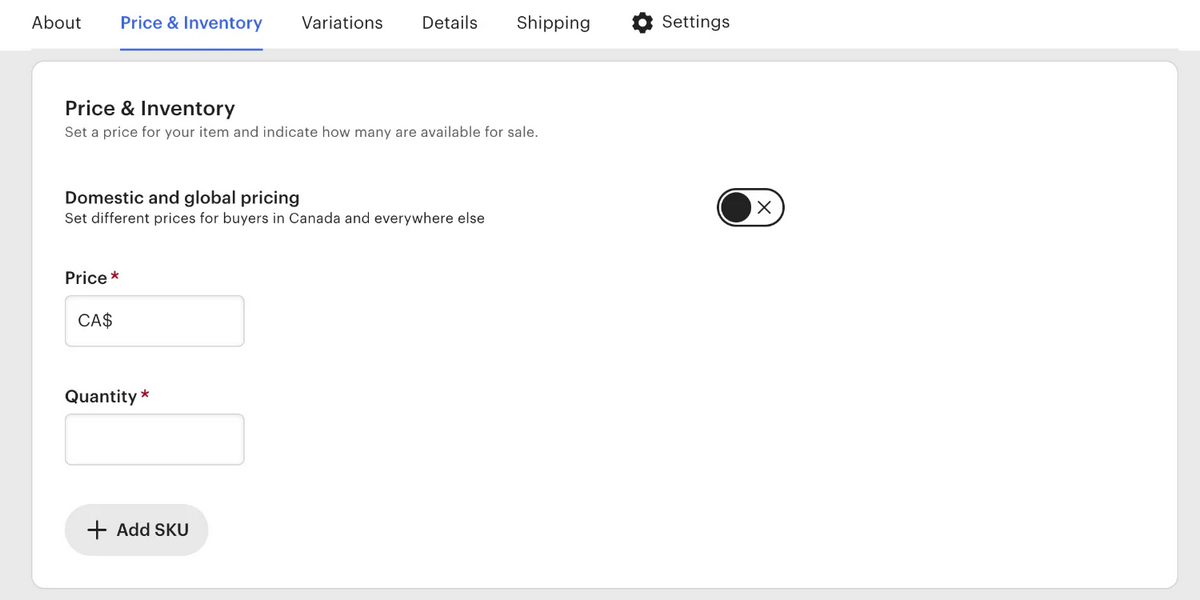
Finally, shipping preferences. You can choose for Etsy to calculate shipping automatically for you, or do it manually. In the first case, you’ll set your shipping rates, origin zip code, processing time, and decide where you’ll ship—just the USA? Other regions? Or worldwide? You choose. Either way, Etsy will work it out for you.
If you do it manually, you can choose your shipping service and rates. You can pick between a fixed shipping rate or free shipping (which shoppers love!).
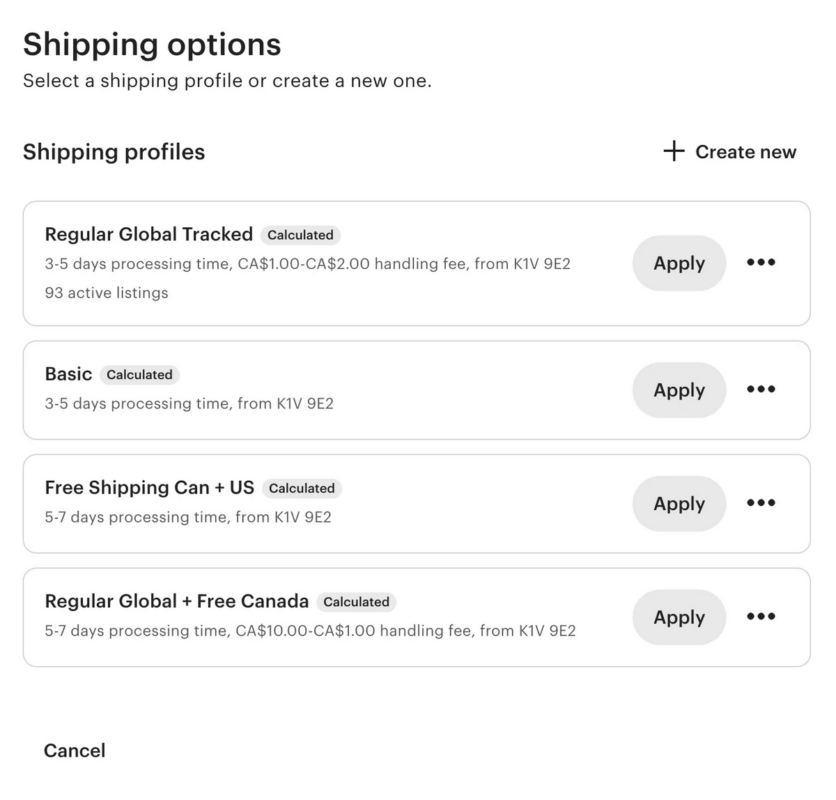
Step 6: Launch and Promote Your Shop
With everything setup, you’re all ready to go live. But don’t stop there. A live shop is just the beginning. Now it’s time to get all the attention on your products.
Start with organic content on social media. Instagram, Pinterest, and TikTok are perfect for Etsy sellers, especially if you’re in a visual niche like home decor, fashion, or art prints. Post consistently, use relevant hashtags, and don’t be afraid to show behind-the-scenes content. This builds trust and personality, perfect for an Etsy community.
You can also test Etsy’s built-in ads (called Etsy Ads) to promote your listings right on the platform. Even a small daily budget can help boost visibility, but you don’t necesarily have to do this. And, honestly? If you nail organic marketing, you don’t have to spend extra money on pay-per-click advertising.
Bonus Step: How to Make Your Etsy Shop Stand Out
Want to separate yourself from the sea of sellers on Etsy? Good news: you don’t need a huge budget. You just need to be intentional and consistent. Let’s see a couple of best practices to level up your shop and build real brand loyalty.
- Automate logistics. Standing out doesn’t just mean looking good. It means making everything look effortless and efficient. Rely on automation to fulfill orders right away, keep stock and prices updated, and send tracking updates. The result? Fewer mistakes and faster delivery, something both you and your customers will appreciate.
- Nail your Etsy SEO. Use relevant keywords in your titles, tags, and descriptions. Think like a buyer. What would you type to find your product? Use long-tail keywords (for example, “custom dog portrait mug” instead of just “dog mug”). Also, update listings regularly based on what’s trending.
- Create eye-catching thumbnails. Your first product image is your billboard. Make it count. Use lifestyle pics or clean mockups that stand out in search results. And no worries, no need for an expert designer. Tools like Canva help you create polished visuals in minutes. ChatGPT is a great tool as well. It can replace the background of a picture to set the product in whatever setting you choose (perfect for lifestyle photos!).
- Offer limited editions or bundles. Urgency sells. Encourage upselling with limited-time deals and bundles. This works especially well for holidays or seasonality (like back-to-school kits or Valentine’s gift sets).
- Deliver good customer service. Fast responses, clear policies, and proactive communication turn one-time shoppers into loyal customers. Dropshipping? No problem. You can still offer a personal touch. Include a thank-you message, offer easy returns, and respond to issues with empathy.
- Collect reviews. Social proof drives sales. Encourage happy customers to leave reviews and respond to them with gratitude. If something goes wrong, handle it quickly and professionally (it shows buyers you care).
Beginner’s Tip: Setting up your store is one thing. Keeping it running smoothly is another. Learn how to set up your Etsy shop tracking in 2025 and boost customer trust.
Frequently Asked Questions
Do I need a business license to open an Etsy shop?
You don’t necessarily need a business licence to open an Etsy shop. That said, your local regulations might request one. To ensure everything is in order, always check your country’s tax and business requirements.
Can I open an Etsy shop for print-on-demand products?
Yes! You can totally open an Etsy shop for print-on-demand (POD) products. Two things to keep in mind. First, make sure to list your POD provider as a production partner. Second, always design your own artwork or customizations.
How long does it take to set up an Etsy store?
You can launch your Etsy shop in just a couple of hours. That said, setting up high-quality listings, a branded store, and the right integrations might take longer. Want to speed things up? Consider using dropshipping tools like AutoDS to automate most of the workflows.
You’re All Set! Etsy Store Setup Made Simple
Yes, we know: starting an Etsy shop might feel overwhelming at first. But once you break it down into little steps, it’s pretty straightforward (even for beginners). Choose your niche, complete the forms in just a few minutes, publish your first listing, and you’re good to go.
But that’s just the beginning. Then, the real fun begins: dropshipping! Once your store is set up, get ready to become best friends with automation.
AutoDS simplifies the entire process, from importing products in one click to automating order fulfillment and keeping track of inventory and prices. Bonus? Everything is centralized in one single place. Bonus x2? No tech skills required.
So go ahead: launch that store, embrace your niche, and let the orders roll in. You’ve got the tools, and here’s more info on Etsy dropshipping to take with you along the way:






